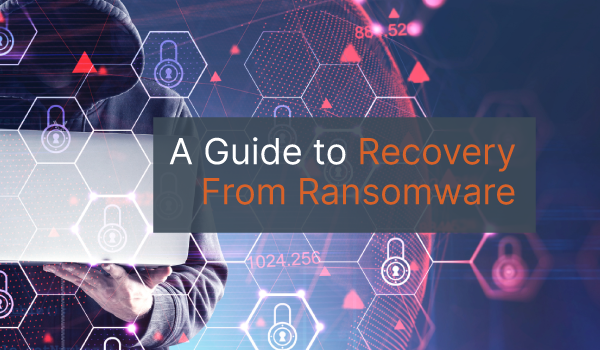Do you get chills down your spine knowing that, at any moment, your organization could experience a ransomware attack and massive disruptions to your operations?
There is reason to be concerned: in a recent study, 76% of businesses experienced a ransomware attack in 2022. More than ever, businesses face probable financial loss from a data breach, with ransomware attacks increasing in prevalence and sophistication. Managing the logistics involved in recovery can feel like a daunting task.
This article covers the basic steps to ensure adequate recovery from ransomware attacks and how to prevent future attacks from occurring in the first place.
What is Ransomware?
Ransomware is a type of malicious software (malware) that commonly uses social engineering to manipulate users into allowing the hacker to infiltrate their system.
Once inside, malware will encrypt your data and/or block your system’s access, holding it hostage until you pay a ransom to decrypt your information. Cybercriminals often demand ransom payments in cryptocurrency, which is difficult to trace. Sometimes hackers will return your data after paying the ransom, but often, this strategy doesn’t help recover your data.
Ransomware Attacks in 2023
In the first half of 2022 alone, businesses globally encountered over 236 million ransomware attacks. Don’t worry, because paying attention to the latest ransomware tactics and cybersecurity trends can help build an effective data protection plan.
In 2023, businesses face increased opportunities to encounter ransomware attacks, particularly with the popularity of IoT devices in the workplace.
Ransomware attacks continue to increase in devastation, with a recent Forbes article pointing out that large organizations can potentially see a financial impact of around $4 million. Among other glaring cybersecurity statistics, they note that businesses should pay attention to common cybercriminal tactics, including the increasing abuse of renowned brand names in their phishing attacks like Microsoft, Amazon, DocuSign, and Google.
Unfortunately, you’re not off the hook for planning for ransomware attacks if you don’t consider yourself a large business, especially given that in 2021, 70% of ransomware attacks affected small businesses.
You’ve Fallen Victim to Ransomware, Now What?
1. Report the Attack
If your business experiences a ransomware attack, it’s crucial to report the data breach to your local law enforcement to help minimize the damage. Once completed, submit a report to an established scam-reporting organization, like the Canadian Anti-Fraud Centre.
2. Update and Clean Systems
Updating and cleaning your system enables your business to restore your infrastructure while diminishing the attack’s impact. The clean-up process involves running a comprehensive antivirus scan on your entire infrastructure for any lingering harmful files or software, including all devices, operating systems, databases, and software. It is also critical to check your backup data so you don’t perpetuate the problem once you restore your assets.
3. Restore Mission-Critical Data
Once your system is malware-free, it’s time to restore your data from your backups, necessitating regular backup of your data in advance. Businesses need a secured backup system that streamlines the process of retrieving backup data. Implementing a protocol to back up your data periodically would be best to ensure your restored data is reliable and recent.
4. Form or Update Your Protection Plan
A proactive and preventative approach can not only thwart a data breach, but it can also help minimize the damage if you do experience one. Your business needs to develop a robust and updated data protection plan. Adopting cybersecurity tools and tactics such as DNS filtering and end-point detection and response (EDR) can allow your business to detect suspicious activity in your IT infrastructure. Your data protection plan should include a strategy to implement user-awareness training to educate your employees on detecting a phishing attempt and stopping a ransomware attack in its tracks.
PC Corp’s Cybersecurity Services
Navigating a challenging digital landscape without guided expertise is like driving your car with your eyes closed, opening up your business to ransomware attacks that could crash your operations and devastate your critical assets.
As part of our Managed IT Services at PC Corp, we offer cybersecurity services to help your organization keep your infrastructure secured, healthy, and working smoothly, so your employees stay productive.
Connect with us today to see how PC Corp can help your business avoid costly disruptions to your performance and productivity. Let’s work together to keep your organization thriving long-term.
